Solar Cell Basics
Solar energy refers to the thermal radiation energy of the sun, which uses sunlight to convert energy into usable forms, such as electricity and heat. Since the birth of life on Earth, it has mainly relied on the thermal radiation energy provided by the sun to survive. Especially now that fossil fuels are dwindling, solar energy has become an important source of energy for human beings. The sun produces an unbelievable amount of energy that reaches the earth. The amount of energy that is absorbed by the Earth in one hour is more energy than mankind uses in one year. The total amount of solar energy reaching the earth in one year is huge - twice as much energy as ever existed from all sources of coal, oil, natural gas, and uranium combined. The theoretical basis of solar cells and solar panels is based on the photoelectric effect, that is, when sunlight shines on a specific semiconductor material, the electrons in the material will be excited and generate an electric current. This effect is the basis for converting solar energy into electrical energy. The utilization of solar energy is mainly through two methods: photothermal conversion and photoelectric conversion. Solar power generation is an emerging renewable energy source.
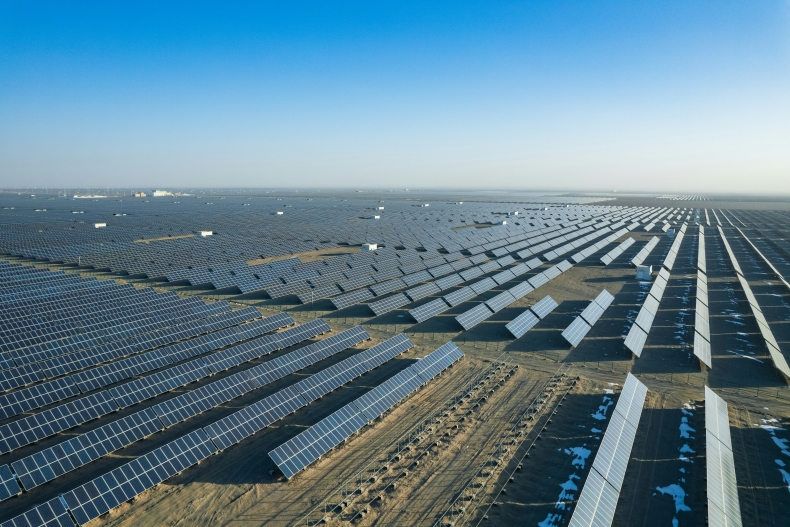
Solar cells are made of various materials, the most common of which include silicon, indium gallium, cadmium selenide, etc. These materials play a vital role in the manufacturing process of solar cells. Silicon is one of the most commonly used solar cell materials at present. It has good semiconductor properties, can generate electron-hole pairs under light and convert them into electrical energy, and has high photoelectric conversion efficiency and stability. Currently, the main types of solar cells include silicon crystal solar cells, thin film solar cells, and some emerging solar cells. The manufacturing processes of various solar cells are constantly being optimized and innovated to improve efficiency, reduce costs, and enhance the stability and durability of the cells. With the advancement of science and technology, new manufacturing technologies and materials may emerge in the future, promoting further innovation in solar cell technology.
When silicon absorbs sunlight, the energy from the sun excites some of the cell's electrons into a mobile state where they are free to move around the entire cell. However, in a piece of plain silicon, there is no reason for it to go in one direction rather than another (electricity is the movement of electrons in one direction). However, in solar cells, there is a separator called a junction, where two slightly different types of silicon meet. The two types of silicon are pretty much the same, except each one is "doped" - has a tiny percentage of other materials mixed in. The two types of doping (called n-type and p-type) determine its electrical properties. When a random electron reaches the junction, it is accelerated across it (think about a waterfall ... the water can only go one way down). So this flow establishes an electron direction in the system. If a wire is attached to each side of the junction, and sunlight is absorbed by the silicon, the free electrons flow from one side of the junction to the other. This flow of electrons induces a similar flow through the external circuit. This is "electricity" - electrons flowing in a single direction through conductors. This particular flow is called a DC current.
An individual silicon solar cell is quite small, typically about 6 inches square producing only about 1 or 2 watts of power. To boost the total power output from solar cells, they are connected together to form larger units called solar modules (panels). These modules are usually encased in glass or plastic to provide protection from the weather. Solar modules, in turn, can be connected to form larger units called solar arrays. These arrays can be interconnected to produce even more power. In this way, solar systems can be built to meet almost any electric power requirement, small or large.

Solar cells are made of various materials, the most common of which include silicon, indium gallium, cadmium selenide, etc. These materials play a vital role in the manufacturing process of solar cells. Silicon is one of the most commonly used solar cell materials at present. It has good semiconductor properties, can generate electron-hole pairs under light and convert them into electrical energy, and has high photoelectric conversion efficiency and stability. Currently, the main types of solar cells include silicon crystal solar cells, thin film solar cells, and some emerging solar cells. The manufacturing processes of various solar cells are constantly being optimized and innovated to improve efficiency, reduce costs, and enhance the stability and durability of the cells. With the advancement of science and technology, new manufacturing technologies and materials may emerge in the future, promoting further innovation in solar cell technology.
When silicon absorbs sunlight, the energy from the sun excites some of the cell's electrons into a mobile state where they are free to move around the entire cell. However, in a piece of plain silicon, there is no reason for it to go in one direction rather than another (electricity is the movement of electrons in one direction). However, in solar cells, there is a separator called a junction, where two slightly different types of silicon meet. The two types of silicon are pretty much the same, except each one is "doped" - has a tiny percentage of other materials mixed in. The two types of doping (called n-type and p-type) determine its electrical properties. When a random electron reaches the junction, it is accelerated across it (think about a waterfall ... the water can only go one way down). So this flow establishes an electron direction in the system. If a wire is attached to each side of the junction, and sunlight is absorbed by the silicon, the free electrons flow from one side of the junction to the other. This flow of electrons induces a similar flow through the external circuit. This is "electricity" - electrons flowing in a single direction through conductors. This particular flow is called a DC current.
An individual silicon solar cell is quite small, typically about 6 inches square producing only about 1 or 2 watts of power. To boost the total power output from solar cells, they are connected together to form larger units called solar modules (panels). These modules are usually encased in glass or plastic to provide protection from the weather. Solar modules, in turn, can be connected to form larger units called solar arrays. These arrays can be interconnected to produce even more power. In this way, solar systems can be built to meet almost any electric power requirement, small or large.
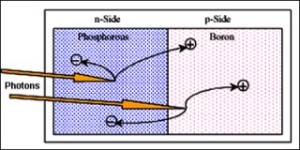 A p/n junction is formed when two types of semiconductors, n-type (excess electrons) and p-type (excess holes), come into contact. The term p/n junction refers to the joint interface and the immediate surrounding area of the two semiconductors. If the joint is made by two separate semiconductor crystals, this is a rough interface known as a grain boundary. A grain boundary has different electrical properties than a single crystalline interface. P/N junctions are normally created in a single crystal of semiconductor by doping each side with different "dopants". The discovery of the p/n junction is usually attributed to American physicist Russell Ohl of Bell Laboratories.
A p/n junction is formed when two types of semiconductors, n-type (excess electrons) and p-type (excess holes), come into contact. The term p/n junction refers to the joint interface and the immediate surrounding area of the two semiconductors. If the joint is made by two separate semiconductor crystals, this is a rough interface known as a grain boundary. A grain boundary has different electrical properties than a single crystalline interface. P/N junctions are normally created in a single crystal of semiconductor by doping each side with different "dopants". The discovery of the p/n junction is usually attributed to American physicist Russell Ohl of Bell Laboratories.
The solar inverter is the core component of the solar photovoltaic system. When sunlight hits the solar panels, the power generated by these panels can only be direct current, and what we need is alternating current, because most electrical equipment uses Alternating current, at this time, the role of the solar inverter becomes apparent. Its main function is to convert DC power generated by solar panels into AC power for domestic, industrial or commercial use, or for feedback into the grid. The design of the inverter must be efficient and reliable to ensure the stability and economy of the solar system. In modern photovoltaic systems, the inverter is not only an energy conversion device, but also often has a communication interface that can be connected to the smart grid system to achieve remote monitoring and management. Through these functions, the inverter facilitates the interaction between the photovoltaic power generation system and the power grid, increasing the intelligence and automation level of the system.
Its main function is to convert DC power generated by solar panels into AC power for domestic, industrial or commercial use, or for feedback into the grid. The design of the inverter must be efficient and reliable to ensure the stability and economy of the solar system. In modern photovoltaic systems, the inverter is not only an energy conversion device, but also often has a communication interface that can be connected to the smart grid system to achieve remote monitoring and management. Through these functions, the inverter facilitates the interaction between the photovoltaic power generation system and the power grid, increasing the intelligence and automation level of the system.
 Its main function is to convert DC power generated by solar panels into AC power for domestic, industrial or commercial use, or for feedback into the grid. The design of the inverter must be efficient and reliable to ensure the stability and economy of the solar system. In modern photovoltaic systems, the inverter is not only an energy conversion device, but also often has a communication interface that can be connected to the smart grid system to achieve remote monitoring and management. Through these functions, the inverter facilitates the interaction between the photovoltaic power generation system and the power grid, increasing the intelligence and automation level of the system.
Its main function is to convert DC power generated by solar panels into AC power for domestic, industrial or commercial use, or for feedback into the grid. The design of the inverter must be efficient and reliable to ensure the stability and economy of the solar system. In modern photovoltaic systems, the inverter is not only an energy conversion device, but also often has a communication interface that can be connected to the smart grid system to achieve remote monitoring and management. Through these functions, the inverter facilitates the interaction between the photovoltaic power generation system and the power grid, increasing the intelligence and automation level of the system.
The sun produces an unbelievable amount of energy that reaches the earth. The amount of energy that is absorbed by the earth in one hour is more energy than mankind uses in one year. 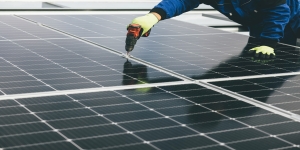 The total amount of solar energy reaching the earth in one year is huge - twice as much energy as ever existed from all sources of coal, oil, natural gas, and uranium combined. The amount of solar energy that reaches any given location varies by latitude, time of year, time of day, and local weather. The theoretical basis of solar cells and solar panels is based on the photoelectric effect, that is, when sunlight shines on a specific semiconductor material, the electrons in the material will be excited and generate an electric current. This effect is the basis for converting solar energy into electrical energy.
The total amount of solar energy reaching the earth in one year is huge - twice as much energy as ever existed from all sources of coal, oil, natural gas, and uranium combined. The amount of solar energy that reaches any given location varies by latitude, time of year, time of day, and local weather. The theoretical basis of solar cells and solar panels is based on the photoelectric effect, that is, when sunlight shines on a specific semiconductor material, the electrons in the material will be excited and generate an electric current. This effect is the basis for converting solar energy into electrical energy.
 The total amount of solar energy reaching the earth in one year is huge - twice as much energy as ever existed from all sources of coal, oil, natural gas, and uranium combined. The amount of solar energy that reaches any given location varies by latitude, time of year, time of day, and local weather. The theoretical basis of solar cells and solar panels is based on the photoelectric effect, that is, when sunlight shines on a specific semiconductor material, the electrons in the material will be excited and generate an electric current. This effect is the basis for converting solar energy into electrical energy.
The total amount of solar energy reaching the earth in one year is huge - twice as much energy as ever existed from all sources of coal, oil, natural gas, and uranium combined. The amount of solar energy that reaches any given location varies by latitude, time of year, time of day, and local weather. The theoretical basis of solar cells and solar panels is based on the photoelectric effect, that is, when sunlight shines on a specific semiconductor material, the electrons in the material will be excited and generate an electric current. This effect is the basis for converting solar energy into electrical energy.
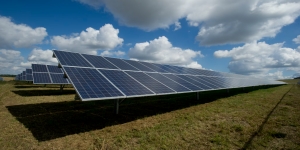 The global solar energy market is in a stage of rapid growth, mainly due to various factors. First, the cost of solar technology has dropped significantly, making solar energy an economically viable energy option in many countries and regions. Second, there is increasing global demand for renewable energy, especially in combating climate change and reducing greenhouse gas emissions. In addition, many countries realize that developing clean energy is not only an effective way to deal with climate change but also a long-term solution to energy security issues.
The global solar energy market is in a stage of rapid growth, mainly due to various factors. First, the cost of solar technology has dropped significantly, making solar energy an economically viable energy option in many countries and regions. Second, there is increasing global demand for renewable energy, especially in combating climate change and reducing greenhouse gas emissions. In addition, many countries realize that developing clean energy is not only an effective way to deal with climate change but also a long-term solution to energy security issues.
 The sun periodically emits a prominence on its surface, a distinctive looking figure that is in its outer atmosphere, the Corona, and many times has a swirl or loop configuration. A prominence is a mass of plasma gases and charged particles that are cooler (60,000 degrees C) than their surroundings (a million degrees C). A typical prominence is a billion tons or more of these gases supported by huge magnetic forces.
The sun periodically emits a prominence on its surface, a distinctive looking figure that is in its outer atmosphere, the Corona, and many times has a swirl or loop configuration. A prominence is a mass of plasma gases and charged particles that are cooler (60,000 degrees C) than their surroundings (a million degrees C). A typical prominence is a billion tons or more of these gases supported by huge magnetic forces.
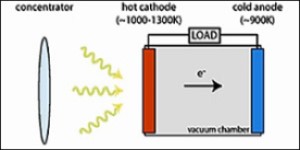 The concept of the Shockley Queisser Efficiency Limit was first formulated by William Shockley and Hans Queisser in1961. It represents the maximum efficiency that any single-junction solar cellcan achieve, typically around 33% under standard test conditions (STC). Theseconditions simulate solar noon during the spring and autumn equinoxes in thecontinental United States, with the solar cell directly facing the sun.
The concept of the Shockley Queisser Efficiency Limit was first formulated by William Shockley and Hans Queisser in1961. It represents the maximum efficiency that any single-junction solar cellcan achieve, typically around 33% under standard test conditions (STC). Theseconditions simulate solar noon during the spring and autumn equinoxes in thecontinental United States, with the solar cell directly facing the sun.
The main way the sun releases energy is through nuclear fusion reactions. The sun's nuclear reaction zone is undergoing a large amount of hydrogen nuclear fusion every second, releasing huge amounts of light and heat energy. 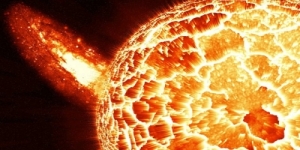 This process has been going on for about 4.6 billion years, making the sun the primary energy source for Earth and the other planets in the solar system. Solar flares are the most intense form of energy release in the solar system. They consist of a violent release of energy on the surface of the sun. Although solar activity is frequent and intense, the specific time and intensity of its outbreak are still difficult to predict. Scientists recommend continuous monitoring of solar activity, to better understand the internal mechanisms and magnetic field changes of the sun.
This process has been going on for about 4.6 billion years, making the sun the primary energy source for Earth and the other planets in the solar system. Solar flares are the most intense form of energy release in the solar system. They consist of a violent release of energy on the surface of the sun. Although solar activity is frequent and intense, the specific time and intensity of its outbreak are still difficult to predict. Scientists recommend continuous monitoring of solar activity, to better understand the internal mechanisms and magnetic field changes of the sun.
 This process has been going on for about 4.6 billion years, making the sun the primary energy source for Earth and the other planets in the solar system. Solar flares are the most intense form of energy release in the solar system. They consist of a violent release of energy on the surface of the sun. Although solar activity is frequent and intense, the specific time and intensity of its outbreak are still difficult to predict. Scientists recommend continuous monitoring of solar activity, to better understand the internal mechanisms and magnetic field changes of the sun.
This process has been going on for about 4.6 billion years, making the sun the primary energy source for Earth and the other planets in the solar system. Solar flares are the most intense form of energy release in the solar system. They consist of a violent release of energy on the surface of the sun. Although solar activity is frequent and intense, the specific time and intensity of its outbreak are still difficult to predict. Scientists recommend continuous monitoring of solar activity, to better understand the internal mechanisms and magnetic field changes of the sun.
Solar energy refers to the thermal radiation energy of the sun, which uses sunlight to convert energy into usable forms, such as electricity and heat.  In a broad sense, solar energy also includes wind energy, chemical energy, water energy, etc. Solar energy is a clean and renewable energy source. Since the birth of life on Earth, it has mainly relied on the thermal radiation energy provided by the sun to survive. Especially now that fossil fuels are dwindling, solar energy has become an important source of energy for human beings, and continues to develop. The utilization of solar energy is mainly through two methods: photothermal conversion and photoelectric conversion. Solar power generation is an emerging renewable energy source.
In a broad sense, solar energy also includes wind energy, chemical energy, water energy, etc. Solar energy is a clean and renewable energy source. Since the birth of life on Earth, it has mainly relied on the thermal radiation energy provided by the sun to survive. Especially now that fossil fuels are dwindling, solar energy has become an important source of energy for human beings, and continues to develop. The utilization of solar energy is mainly through two methods: photothermal conversion and photoelectric conversion. Solar power generation is an emerging renewable energy source.
 In a broad sense, solar energy also includes wind energy, chemical energy, water energy, etc. Solar energy is a clean and renewable energy source. Since the birth of life on Earth, it has mainly relied on the thermal radiation energy provided by the sun to survive. Especially now that fossil fuels are dwindling, solar energy has become an important source of energy for human beings, and continues to develop. The utilization of solar energy is mainly through two methods: photothermal conversion and photoelectric conversion. Solar power generation is an emerging renewable energy source.
In a broad sense, solar energy also includes wind energy, chemical energy, water energy, etc. Solar energy is a clean and renewable energy source. Since the birth of life on Earth, it has mainly relied on the thermal radiation energy provided by the sun to survive. Especially now that fossil fuels are dwindling, solar energy has become an important source of energy for human beings, and continues to develop. The utilization of solar energy is mainly through two methods: photothermal conversion and photoelectric conversion. Solar power generation is an emerging renewable energy source.
 Solar energy's development commenced in 1839 when French physicist Alexander Edmond Becquerel (1820-1891) conducted research that led to the discovery of the "photovoltaic (PV) effect." While experimenting with a solid electrode in an electrolyte solution at the age of 19 in his father's laboratory, Becquerel observed the development of voltage when light struck the electrode. This phenomenon, later termed the Becquerel Effect, marked the foundational understanding of solar energy conversion.
Solar energy's development commenced in 1839 when French physicist Alexander Edmond Becquerel (1820-1891) conducted research that led to the discovery of the "photovoltaic (PV) effect." While experimenting with a solid electrode in an electrolyte solution at the age of 19 in his father's laboratory, Becquerel observed the development of voltage when light struck the electrode. This phenomenon, later termed the Becquerel Effect, marked the foundational understanding of solar energy conversion.
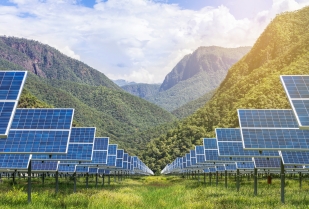
Category
Featured Articles
Expanding Research on Solar Energy ...
The application fields of solar energy are very wide, covering many fields such as the photonic industry, new energy photothermal ...
Exploring Concentrated Solar Power ...
Concentrated Solar Power (CSP) systems use very different technology than photovoltaic systems. CSP systems use the sun as the ...
Solar Cell Manufacturing Process
Solar cells are made of various materials, the most common of which include silicon, indium gallium, cadmium selenide, etc. These ...
The Evolution of Grid Electricity ...
"Electricity" cannot be stored on the grid; generation must be approximately equal to consumption at all times. However, ...
Solar Activity: Sunspots, Magnetism & ...
Solar activity refers to a series of complex phenomena in the solar atmosphere, including sunspots, flares, prominences, coronal ...
